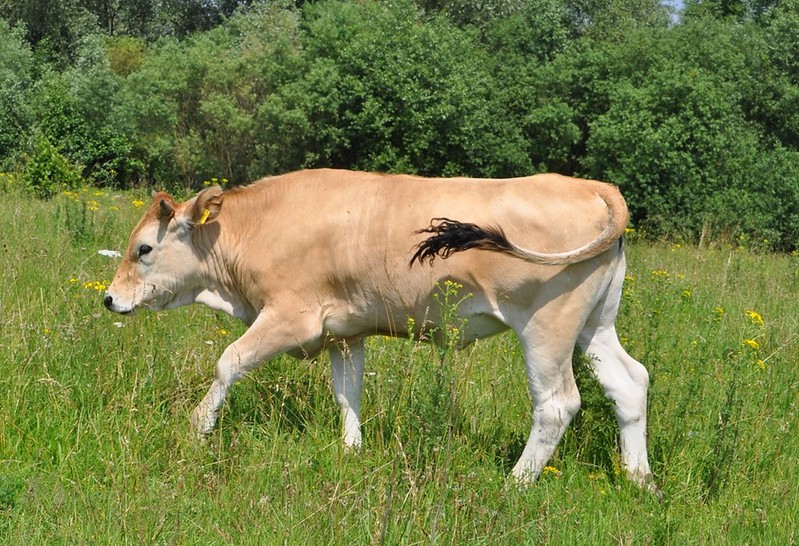One of these crossbreeds - a cow named Bionade - was already introduced in this post.
Actually it is unnecessary to examine the looks of a first-generation crossbreed because it does genetically not make sense, but let's do it for fun. Its colour is definitely wildtype-coloured but very diluted. The legs are long and the trunk short, but the head is small and the horns point skywards. I am curious whether the head will grow more elongated (the cow was about 2 years old when I took that photo). I don't remember well enough to estimate her size.
I was very curious what a bull of this combination would look like, and few days ago Matthias Scharf from the ABU kindly provided me with a recent photo:
Now imagine a herd composed exclusively of F1 Sayaguesa x Chianina animals. Considering the long generation span of cattle, efficient linebreeding to unite all the desired features and clear off all undesired traits would take very long. But perhaps (true) F2 or F3 would be enough to get some acceptable cattle that are large, long-legged and have a muscular and slender body plus a well-developed hump and not that much dilution factors. Probably sexual dichromatism would surface in a number of individuals (Perhaps an undiluted cow of this combination might have a similar colour to this cow which is mainly composed of these two breeds).
Despite the probably still quite small horns, such animals surely would be prime breeding bulls for any Heck/Taurus herd. The bull above most likely will not become a breeding bull in the Lippeaue, but I hope he won't get slaughtered. He probably would be helpful to a herd like those at Wörth or the Neandertal, because he adds what they usually lack.



It is impossible to bring the Auerochs back. The only thing we can do ist to create a cattlerace looking like auerochs and behave like auerochs.
ReplyDeleteI am perfectly aware of that and actually wrote that several times actually. "Breeding-back" simply is an uncomfortable name and I don't know a better one. But there actually is one way to bring the aurochs back, cloning.
DeleteYou know, with these rewilding process, i realize the interest, and i too appreciate a diverse wildlife with beautiful interesting species. But i kind of don't understand the need of absolute authenticity to the original specimen, i mean there were never really such a thing as a 100% original specimen since evolution is ongoing. I only see the need for an animal that kan make up well for the original animal in characteristics, which i guess is what Tauros is aiming to do. The original animal sill never come back without cloning, so aim for a beautiful, hardy animal that fits the geological purpose its desired for. Dont bother try to make an exact replica, but emphasize desired traits within the animal.
Delete